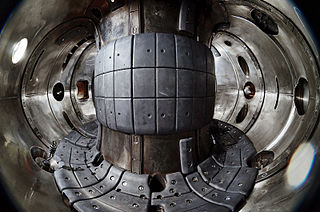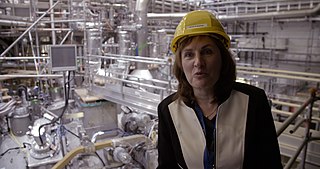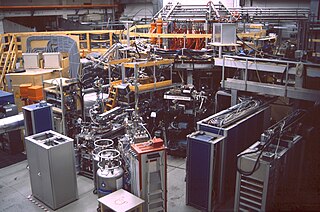Related Research Articles

The stability of a plasma is an important consideration in the study of plasma physics. When a system containing a plasma is at equilibrium, it is possible for certain parts of the plasma to be disturbed by small perturbative forces acting on it. The stability of the system determines if the perturbations will grow, oscillate, or be damped out.
An edge-localized mode (“ELM”) is a disruptive instability occurring in the edge region of a tokamak plasma due to the quasi-periodic relaxation of a transport barrier previously formed during a transition from low to high-confinement mode. This phenomenon was first observed in the ASDEX tokamak in 1981.
Ion cyclotron resonance is a phenomenon related to the movement of ions in a magnetic field. It is used for accelerating ions in a cyclotron, and for measuring the masses of an ionized analyte in mass spectrometry, particularly with Fourier transform ion cyclotron resonance mass spectrometers. It can also be used to follow the kinetics of chemical reactions in a dilute gas mixture, provided these involve charged species.
John Bryan Taylor is a British physicist known for his contributions to plasma physics and their application in the field of fusion energy. Notable among these is the development of the "Taylor state", describing a minimum-energy configuration that conserves magnetic helicity. Another development was his work on the ballooning transformation, which describes the motion of plasma in toroidal (donut) configurations, which are used in the fusion field. Taylor has also made contributions to the theory of the Earth's Dynamo, including the Taylor constraint.
The ballooning instability is a type of internal pressure-driven plasma instability usually seen in tokamak fusion power reactors or in space plasmas. It is important in fusion research as it determines a set of criteria for the maximum achievable plasma beta. The name refers to the shape and action of the instability, which acts like the elongations formed in a long balloon when it is squeezed. In literature, the structure of these elongations are commonly referred to as 'fingers'.

A ball-pen probe is a modified Langmuir probe used to measure the plasma potential in magnetized plasmas. The ball-pen probe balances the electron and ion saturation currents, so that its floating potential is equal to the plasma potential. Because electrons have a much smaller gyroradius than ions, a moving ceramic shield can be used to screen off an adjustable part of the electron current from the probe collector.

COMPASS, short for Compact Assembly, is a compact tokamak fusion energy device originally completed at the Culham Science Centre in 1989, upgraded in 1992, and operated until 2002. It was designed as a flexible research facility dedicated mostly to plasma physics studies in circular and D-shaped plasmas.

Sir Steven Charles Cowley is a British theoretical physicist and international authority on nuclear fusion and astrophysical plasmas. He has served as director of the United States Department of Energy (DOE) Princeton Plasma Physics Laboratory (PPPL) since 1 July 2018. Previously he served as president of Corpus Christi College, Oxford, since October 2016. and head of the EURATOM / CCFE Fusion Association and chief executive officer of the United Kingdom Atomic Energy Authority (UKAEA).

Sibylle Günter is a German theoretical physicist researching tokamak plasmas. Since February 2011, she has headed the Max Planck Institute for Plasma Physics. In October 2015, she was elected a member of the Academia Europaea in recognition of her contribution to research.
High-confinement mode, or H-mode, is an operating mode possible in toroidal magnetic confinement fusion devices – mostly tokamaks, but also in stellarators. In this mode the plasma is more stable and better confined.

A sawtooth is a relaxation that is commonly observed in the core of tokamak plasmas, first reported in 1974. The relaxations occur quasi-periodically and cause a sudden drop in the temperature and density in the center of the plasma. A soft-xray pinhole camera pointed toward the plasma core during sawtooth activity will produce a sawtooth-like signal. Sawteeth effectively limit the amplitude of the central current density. The Kadomtsev model of sawteeth is a classic example of magnetic reconnection. Other repeated relaxation oscillations occurring in tokamaks include the edge localized mode (ELM) which effectively limits the pressure gradient at the plasma edge and the fishbone instability which effectively limits the density and pressure of fast particles.
Miklos Porkolab (born March 24, 1939) is a Hungarian-American physicist specializing in plasma physics.
The Prairie View (PV) Rotamak is a plasma physics experiment at Prairie View A&M University. The experiment studies magnetic plasma confinement to support controlled nuclear fusion experiments. Specifically, the PV Rotamak can be used as either a spherical tokamak or a field-reversed configuration. Some time between 2015 and 2017, all personnel left the project, leaving it vacant.
Jose A. Boedo is an American plasma physicist and a researcher at University of California, San Diego. He is an Elected Fellow of the American Physical Society, which was awarded in 2016 for "his ground-breaking contributions to the studies of plasma drifts and intermittent plasma transport in the peripheral region of tokamaks".
Hartmut Zohm is a German plasma physicist who is known for his work on the ASDEX Upgrade machine. He received the 2014 John Dawson Award and the 2016 Hannes Alfvén Prize for successfully demonstrating that neoclassical tearing modes in tokamaks can be stabilized by electron cyclotron resonance heating, which is an important design consideration for pushing the performance limit of the ITER.
Dmitri Dmitriyevich Ryutov is a Russian theoretical plasma physicist.
Kunioki Mima is a Japanese plasma physicist. He is known for his contributions to the theory of turbulent transport in plasmas, and in particular the derivation of the Hasegawa–Mima equation in 1977, which won him the 2011 Hannes Alfvén Prize.
Patrick Henry Diamond is an American theoretical plasma physicist. He is currently a professor at the University of California, San Diego, and a director of the Fusion Theory Institute at the National Fusion Research Institute in Daejeon, South Korea, where the KSTAR Tokamak is operated.
Friedrich E. Wagner is a German physicist and emeritus professor who specializes in plasma physics. He was known to have discovered the high-confinement mode of magnetic confinement in fusion plasmas while working at the ASDEX tokamak in 1982. For this discovery and his subsequent contributions to fusion research, was awarded the John Dawson Award in 1987, the Hannes Alfvén Prize in 2007 and the Stern–Gerlach Medal in 2009.

Wendelstein 7-AS was an experimental stellarator which was in operation from 1988 to 2002 by the Max Planck Institute for Plasma Physics (IPP) in Garching. It was the first of a new class of advanced stellarators with modular coils, designed with the goal of developing a nuclear fusion reactor to generate electricity.
References
- ↑ Gale Group. (2004). American men & women of science. Gale. OCLC 1082415302.
- 1 2 "2018 James Clerk Maxwell Prize for Plasma Physics Recipient". American Physical Society. Retrieved February 28, 2020.
- ↑ Burrell, K. H.; Doyle, E. J.; Gohil, P.; Groebner, R. J.; Kim, J.; La Haye, R. J.; Lao, L. L.; Moyer, R. A.; Osborne, T. H.; Peebles, W. A.; Rettig, C. L. (1994). "Role of the radial electric field in the transition from L (low) mode to H (high) mode to VH (very high) mode in the DIII‐D tokamak*". Physics of Plasmas. 1 (5): 1536–1544. Bibcode:1994PhPl....1.1536B. doi:10.1063/1.870705. ISSN 1070-664X.
- ↑ Burrell, K H; Austin, M E; Brennan, D P; DeBoo, J C; Doyle, E J; Gohil, P; Greenfield, C M; Groebner, R J; Lao, L L; Luce, T C; Makowski, M A (2002). "Quiescent H-mode plasmas in the DIII-D tokamak". Plasma Physics and Controlled Fusion. 44 (5A): A253–A263. Bibcode:2002PPCF...44A.253B. doi:10.1088/0741-3335/44/5a/325. ISSN 0741-3335.
- ↑ Burrell, K. H.; Osborne, T. H.; Snyder, P. B.; West, W. P.; Fenstermacher, M. E.; Groebner, R. J.; Gohil, P.; Leonard, A. W.; Solomon, W. M. (2009). "Quiescent H-Mode Plasmas with Strong Edge Rotation in the Cocurrent Direction". Physical Review Letters. 102 (15): 155003. Bibcode:2009PhRvL.102o5003B. doi:10.1103/physrevlett.102.155003. ISSN 0031-9007. PMID 19518641.
- ↑ Burrell, Keith H.; Lietzke, Alan F.; Schaffer, Michael J. (1978). "A Diagnostic Method for Time Resolved Spatial Profile Measurements of Proton and Impurity Density and Temperature". IEEE Transactions on Plasma Science. 6 (2): 107–120. Bibcode:1978ITPS....6..107B. doi:10.1109/TPS.1978.4317101. ISSN 1939-9375. S2CID 12422949.
- ↑ Chrystal, C.; Burrell, K. H.; Grierson, B. A.; Pace, D. C. (2015). "Spatial calibration of a tokamak neutral beam diagnostic using in situ neutral beam emission". Review of Scientific Instruments. 86 (10): 103509. Bibcode:2015RScI...86j3509C. doi:10.1063/1.4933337. ISSN 0034-6748. OSTI 1224227. PMID 26520957.
- ↑ "APS Fellow Archive". www.aps.org. Retrieved February 28, 2020.
- ↑ "2001 John Dawson Award for Excellence in Plasma Physics Research Recipient". American Physical Society. Retrieved February 28, 2020.